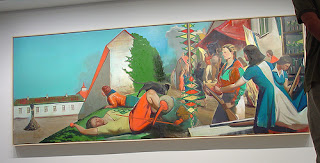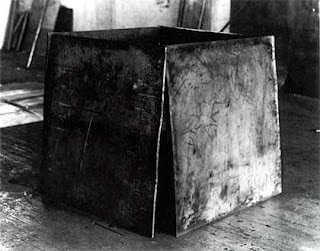Making a Home, a fascinating, multi-sensory survey of Japanese artists living in New York City, is an invigorating and often whimsically fun exploration of the play between these two distinctive cultures. Loosely organized by curator Eric C. Shiner into six thematic currents, the show displays an incredible diversity while investigating issues such as consumerism, intimacy, mourning, and the artistic process itself. While weaker individual pieces sometimes fall behind the venturesome pace and ill-begotten curatorial choices interfere with some of the strongest work, the overall impression is one of sprightly intellectual curiosity and effervescent cultural mingling.
Immediately upon entering the Japan Society, the viewer is confronted with My Mommy is Beautiful, a wall-sized piece by Yoko Ono that invites the audience to record memories of their loved ones upon a neutral white background. While any exhibition claiming to be a comprehensive presentation of New York-based Japanese artists must include Ono, I found her piece to be trite and cloyingly sentimental. I took part in Ono’s memory-celebration, and it felt nice to do so, but it left no lasting impression and said nothing profound about the role of remembrance as a ubiquitous artistic practice. That concept could be fascinating if it was given a more thoughtful treatment, but it remains syrupy and undeveloped in its current incarnation.

The most striking work of the show is also the easiest to miss due to some perplexing curatorial choices. Silent Staircase, by Yasunao Tone, uses modern ultra-directional speakers to create a contained, surreal soundscape within the bustling lobby of the Japan Society. As you walk under Tone’s creation, the speakers negate the surrounding babble of the lobby’s waterfall, creating an invisible cone of insulating, otherworldly noise that doesn’t so much engulf the viewer as transport them. As part of the Building an Environment portion of the exhibition, Tone’s technological alchemy uses sound to ‘build’ an environment while simultaneously mystifying its conventional attributes. The piece is the most conceptually innovative and playful treatment of the theme in the exhibition, though it is hard to spot due to insufficient labeling and an unexplainable separation from the rest of the show.

The conceptual landscapes of Tōru Hayashi, also inexplicably secreted away from the body of the exhibition, nonetheless remain the most striking work of the Referencing the Landscape exhibition theme. Hayashi’s Equivocal Landscape consists of hundreds of tiny, simplified drawings of trees that float amid the white void of his sketchbook pages. They have an undeniably endearing quality, adorably captivating while avoiding the saccharine sweetness of Ono’s work. But in their resemblance to hieroglyphics and their serialized presentation, the drawings also suggest a runic language of mystical universality. They capture the essential meaning of the trees, interpreting the subject through its most fundamental characteristics.

Hayashi expands this investigation of his surroundings in the Metropolis Mandala Series, which he completes after exploring a city for days. He searches for illusive changes in the metropolitan landscape, seeking indications of a city’s intrinsic character and how it subtly shifts over time. Hayashi’s mandalas are prismatic, vaguely spiritual records of these impressions. The artist explains, “The term mandala can be translated as ‘integration of truth.’ I reinterpreted it to demonstrate the ‘intergration of time.’”
Reminiscent of the painterly musings of Paul Klee, the pieces produce a cosmology of fleeting sensation and perceptual mystery. Hayashi has created mandalas of New York, Paris, Tokyo, and Delhi, finding metaphysical calm within the globalist trends of transience and migration. The subtle expressionism and precious scale of his work are refreshingly unique in a show replete with grandiose, room-sized installations.
Of the larger installations, Hiroshi Sunairi’s White Elephant stands out for its ghostly starkness and elegiac immediacy. Part of the Coping with Loss exhibition theme, the piece presents a life-sized porcelain reproduction of an adolescent elephant, shattered into withered pieces and strewn about a black vacuum. Viewers are drawn to walk amongst the artist’s charnel house and contemplate the sepulchral stillness of the fragmented goliath. Sunairi’s mournful response to the terrorist attacks of 9/11, the piece explores the capriciousness of life and death with the staid elegance of a Dutch still life.
Yumi Kōri’s installation Shinkai uses sound and light to create a transcendental experience of space and time. Shinkai, which means “deep sea,” morphs the gallery space into an ethereal realm filled with crystalline bubbles and undulating red lights. Ambient sounds submerse the viewer and reinforce the deep ocean effect. As part of the Meditative Space exhibition theme, Kōri’s installation makes clever use of mirrors to stretch the visual stratum into the infinite, presenting a calming but altogether alien sanctum. Confounding the viewer’s relationship to his environment, the piece creates a nebulous, amniotic otherworld that invites meditative disengagement from everyday reality.

The exhibition’s overriding theme of making a home results in a myriad of imaginative treatments of space, ranging from the metaphysical landscapes of Tōru Hayashi to Hiroshi Sunairi’s mournful Golgotha. Although similar currents are difficult to conjure, many of these artists make ingenious use of technology and Eastern religious practices to strategize an increasingly global world. The exhibition, though sometimes hindered by perplexing curatorial decisions, offers a fantastic survey of these trans-cultural visual strategies and the Japanese New Yorkers who adopt them.
Making a Home: Japanese Contemporary Artists in New York
Japan Society
Through January 13, 2008














